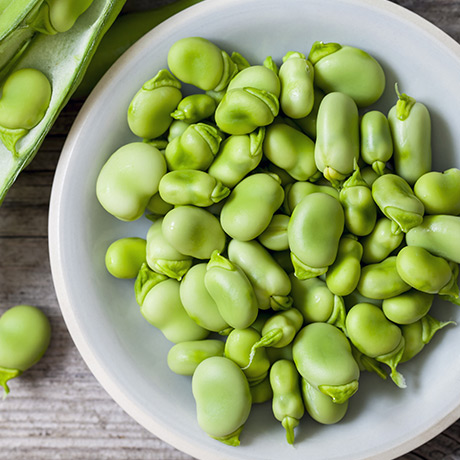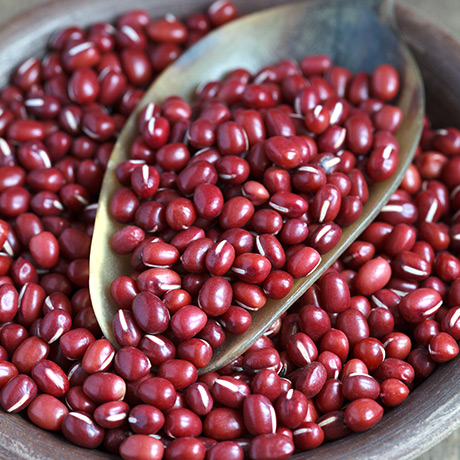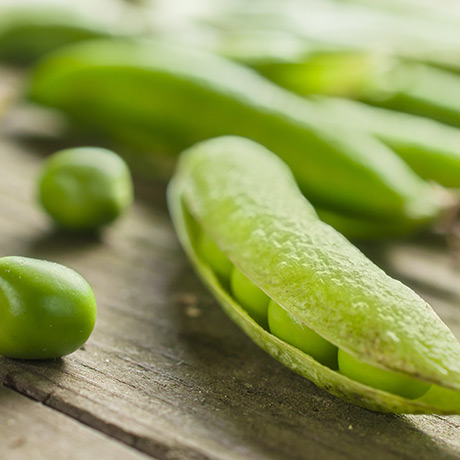- Strawberries
- Cook With Apples
- Grapes
- Grapefruit
- Lemons
- Cabbage
- Asparagus
- All About Bulb Vegetables
- All About Cruciferous Vegetables
- Squash
- All About Root Vegetables
- The Gift of Spice
- Thyme
- Basil
- Raspberries
- All About Tuber Vegetables
- Marjoram / Oregano
- Lemongrass / Citronella
- All Our Fruits, Vegetables and Fresh Herbs
- All About Exotic Fruits
- All About Legumes
- Cooking Pears: Three Inspirational Methods
All About Legumes

Legumes offers a multitude of essential nutrients and generally are a good source of protein, vitamins and fibre. Many legumes help regulate blood glucose levels, providing sustainable energy throughout the day — it’s no wonder they are a key ingredient in most vegetarian diets! Not sure where to start? Here are some great varieties to try.
Broad bean
Rich in protein, broad beans are a great source of fibre and are easily identified by their long shell inside of which flat beans are found. The beans themselves are covered in a fine film that’s removed before eating. Broad beans are sold fresh or frozen. They are also found at the grocery store as dried beans. Fresh beans will keep in the refrigerator, but no more than 2 days.

Chickpea (garbanzo)

The chickpea, also called the garbanzo, is undoubtedly the oldest of all foods. Over 7,000 years old, it has been cultivated in India and along the Mediterranean basin since Antiquity. Depending on the variety, the chickpea can be more or less round, slightly dented and can vary in colour from cream to brown. The chickpea has a very creamy texture that makes it very versatile. It is used in a multitude of recipes and is the basic ingredient in hummus, falafels, and many other Middle Eastern dishes including the traditional couscous. Chickpeas can be found dried or canned.
Cow peas (black-eyed peas)
There are several varieties of cow peas, the best known being the black-eyed pea, which was introduced in the Southern United States during the slave trade. It is used to make the traditional “pork and beans”. There are over 7,000 varieties of black-eyed peas. It is sold dried and should always be soaked prior to cooking. The soaking liquid should be discarded and fresh water should be used to cook the beans. Once cooked, they can be served hot, cold or puréed. They can be added to soups and salads or used as a spread.

Flageolet

The flageolet is a dried bean that is light green bordering on white, thin, flat and less mealy than other legumes. They should always be soaked prior to cooking. The soaking liquid should be discarded and fresh water should be used to cook the beans. In France, they are traditionally served with roasted leg of lamb. These beans hold their shape well after cooking and are especially good in salads.
Adzuki bean
Cultivated in Asia for centuries, it is one of the most popular beans in the world today. The adzuki bean is a small, dark red bean that has a very sweet flavour. It is used to make red bean paste, a basic ingredient in many Asian desserts, and also used in salty dishes. The adzuki bean is delicious simply with rice. It can be used as a coffee substitute and can be popped like popcorn or sprouted like other beans. It is a dried bean so should be soaked prior to cooking.

Scarlet runner bean

Also called the heirloom bean and rattlesnake bean, the scarlet runner bean has been cultivated for over 4,000 years. In fact, Indigenous Mexicans had been eating a wild variety 9,000 years ago. The runner bean pairs particularly well with onions, tomatoes and tuna. It is prepared like all other dried beans.
Lima bean (butter bean)
The lima bean has existed in Peru for more than 7,000 years. The lima bean, also called the butter bean, is a large, oval, cream-coloured bean that has a soft and creamy texture. Puréed, lima beans can replace potatoes. Their delicate flavour makes them ideal to use in recipes where stronger-tasting beans would dominate the taste of other foods. The lima bean is sold canned and dried.

Mung bean

The mung bean has been cultivated for centuries and plays a major role in Indian and Asian cuisine. The mung bean is typically sold dried. It is often used in curries, stews or puréed for soups and dips. Mung bean flour is used to make cellophane noodles and the bean sprouts are the basic ingredient in chop suey.
Pinto bean
The flat, kidney-shaped pinto bean is pale pink to beige and speckled with light brown. Like other similarly dried legumes, the spots disappear as the beans cook. The flesh turns pink and becomes very creamy. Pinto beans are often used to make purée and refried beans. They can be found canned and dried.

Red kidney bean

The red kidney bean is the most popular bean on the planet. It is a good all-purpose bean that’s firm with burgundy skin, white flesh and slightly mealy texture and sweet flavour. The red kidney bean is used in chili con carne. Once cooked, it holds its shape and texture well which makes it ideal to use in casseroles, stews and soups. Red kidney beans can be found dried or canned.
Black bean (turtle bean)
Also called the turtle bean, the kidney-shaped black bean, as its name indicates, is completely black. It is a staple in Mexican cuisine, being the basic ingredient in burritos and enchiladas. In Latin America and the Caribbean, it is used to make black bean soup, while in China and Asia, it is used to make black bean sauce. Black beans are typically sold dried.

Lentil

The lentil is one of the oldest cultivated crops with traces dating back 8,000 years. It is a basic food in many countries for a very long time. The most common varieties found in North America are brown and green lentils. They are round, slightly convex and have a mild, nutty flavour. They are packed with protein and used in hearty soups and casseroles as well as in salads. Unlike most other legumes, lentils do not need to be pre-soaked and cook faster than other dried beans.
White lupine bean
The lupine bean has been cultivated in Europe, the Middle East and North Africa for a very long time but it is still relatively unknown in North America. Of the many varieties, the most often used is the white lupine bean. It is served as an appetizer or snack, like olives. White lupine bean should be pre-soaked and cooked. The flour is used in sauces, soups, pastas and different bakery items including bread.

String bean

The string bean is the fruit of a plant native to South America that has been cultivated by the Mexicans and Peruvians for over 7,000 years. There are over a hundred varieties of string beans, all with different shapes, colours and flavours. They are divided into three categories: the green bean, the yellow bean and the French bean or haricot, which is the smallest and skinniest. It is usually served cooked and most often as a side dish. Fresh, unwashed string beans placed in a perforated plastic bag will keep in the refrigerator for two to three days. They can also be found frozen.
Fresh and dried peas
The pea comes to us from Asia and has been enjoyed for thousands of years. At the end of the 19th Century, it became the first vegetable ever to be cross-bred when it was finally introduced in America.
The pea grows in a smooth green pod that is elongated and slightly curvy. Fresh seeds are called green peas, while dehydrated seeds are called dry peas. Dry peas can be yellow or green; they are sold whole or split. Smooth round peas are usually frozen, while sweet wrinkled peas are generally canned. Fresh peas are highly perishable, so should be eaten as soon as possible. Peas make a tasty side dish for meat and poultry and are often made into soups or added to casseroles.

Split pea

Split peas are yellow or green peas split in half. Less starchy than other varieties, they cook more quickly, taking about 90 minutes or less. Split peas are generally used to make mushy peas. They are also used in clear soups, cream soups or served as a side dish to main meals.
Snow pea
Unlike other peas, the snow pea has a sweet and crunchy, edible pod. Snow peas are also called Chinese pea pods and are used in a great many Chinese recipes. Raw or cooked, snow peas can be prepared as appetizers, side dishes and salads. Blanch for one or two minutes and remove the stem and string from the pod before freezing.

Peanut

Native to South America, the Aztecs were the first to cultivate the peanut. In the 15th century, Spanish and Portuguese sailors introduced the peanut in Africa. Later on, the slave trade brought it to North America. Towards the end of the 19th century, the Americans decided to commercialize peanuts on a grand scale and developed peanut butter as we know it today.
Though the peanut is considered to be a nut, in actual fact, it is a legume that is part of the family that includes peas, dry beans and string beans. They can be eaten whole, mashed, ground, creamed, plain, salted, dry-roasted or covered in chocolate. The peanut is a main ingredient in South American, African and Indonesian cooking where it is used to complement fish, meat, poultry, soups, sauces, salads and desserts. Satay sauce found in Asian cuisine is made with peanuts.
Show your love for legumes with these recipes!










